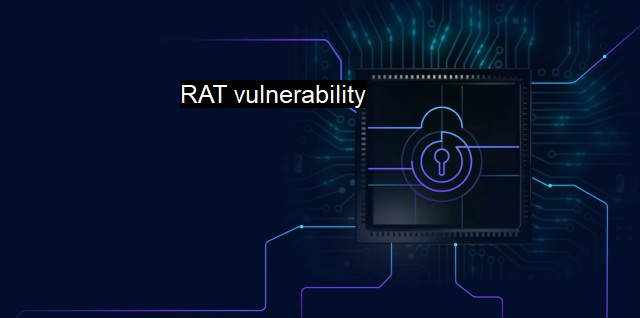What is RAT vulnerability?
Uncovering the Threat: Understanding and Defending Against Remote Administration Tool Vulnerabilities in Cybersecurity.
RAT stands for Remote Access Trojan, a program that propagates itself onto a system with user interactions such as a user opening an email attachment, playing interactive network games or downloading files. Once the RAT enters the user's system, it can exercise significant control over that system to achieve exploitation, such as keyloggers, steal passwords, or block data flow, leading to what is technologically referred to as RAT vulnerability.RAT vulnerability denotes a system's susceptibility to allowing these harmful programs access to the user's computing unit, dealing significant damage under the radar. Whether launched by hackers or insider agents, this program provides an interface that allows unauthorized remote access to the user's system.
RAT vulnerability can illuminate personal as well as corporate data to business. One alarming characteristic of the Remote Access Trojan is its continued presence over extended periods. It is designed to hide within the invaded system and continue transmitting data back to the invading body unnoticed. This means that once this Trojan infects the system, it can generate continual data breaches without calling attention to itself. It's like having a covert agent working against your system, shepherding valuable data to the other end stealthily.
A system's RAT vulnerability level significantly hinges on the level of user awareness provided to operators. The user could unknowingly open a bridge for the Trojan into the system through risky cyber behavior. Spam links, suspect websites, or malicious advertisements do not always arm themselves with glaring red lights to alert naïve users.
Taking this into account, it is important to understand the monumental role of cybersecurity in mitigating the impact of this threat. Cybersecurity is crucial in exercising extensive control to counteract the passivity forced onto our end by these style attacks. One effective method of buffering RAT vulnerability or rendering it impotent completely is the installation and regular updating of trustworthy antivirus software.
Antivirus software's purpose is to identify, neutralize, and remove malware, among which the Remote Access Trojan is one. By comparison tests, this software staves off malware into the labyrinth of encoded language. It thwarts entry attempts by Trojans at the gateway through which they need to pass to access the trove of valuable user data.
In the case of penetration, antivirus anticipates alterations in file behavior and directory structures, enabling the recognition of the harmful file through abnormal behavioral character. This cognizance of post-penetration alternate system behavior is essential to effective cybersecurity. On detection, the antivirus further proceeds to isolate, neutralize, and remove malicious existence.
All told, Remote Access Trojans (RATs) pose a significant threat to system security. But through rigorous application of cyber safety protocols, backing up important data, adequate user knowledge dissemination supplemented with dependable antivirus software, the risk attached with RAT vulnerability can be controlled, if not completely eliminated.
While single miraculous antidotes to RAT vulnerability don't currently exist, this combination of preemptive barriers minimizing the risk damage and a reactionary measure when (and if) the Trojan does breach can create a relatively safe cyber environment. The victory lies in remaining aptly adaptable to shifting styles of breaches as these menaces continually birth new means to exploit system fragility. winning doesn't mean killing off the enemy, it means surviving the fight and being adequately prepared when the next attack wave hits, hopefully with stronger defenses than before.

RAT vulnerability FAQs
What is rat vulnerability in cybersecurity?
RAT stands for Remote Access Trojan. RAT vulnerability refers to the security flaw in computer systems that can be exploited by hackers using a RAT program to gain unauthorized access to the victim's machine remotely.What are the consequences of RAT vulnerability?
If a computer system is vulnerable to RAT attacks, hackers can take complete control over it without the owner's knowledge. They can steal sensitive data, install keyloggers, download or upload files, and run any command on the victim's computer remotely. This can result in financial loss, identity theft, and other cybercrimes.How can I protect myself from RAT vulnerability?
To protect your computer system from RAT attacks, you should always keep your antivirus software up-to-date and scan your system regularly. Also, avoid downloading suspicious files or opening unknown attachments from untrusted sources. Use strong passwords and enable two-factor authentication for sensitive accounts.What should I do if I suspect a RAT attack on my computer system?
If you suspect a RAT attack on your system, immediately disconnect your computer from the internet and run a full system scan using your antivirus software. Change your passwords for all online accounts and monitor your financial transactions and personal information closely. If the problem persists, seek professional help from a cybersecurity expert to remove the malware and repair your system.| | A | | | B | | | C | | | D | | | E | | | F | | | G | | | H | | | I | | | J | | | K | | | L | | | M | |
| | N | | | O | | | P | | | Q | | | R | | | S | | | T | | | U | | | V | | | W | | | X | | | Y | | | Z | |
| | 1 | | | 2 | | | 3 | | | 4 | | | 7 | | | 8 | | |||||||